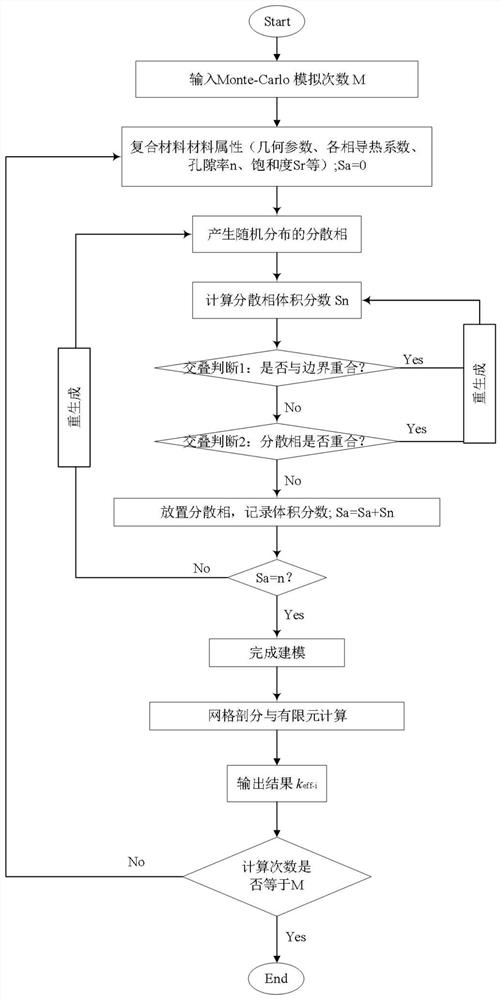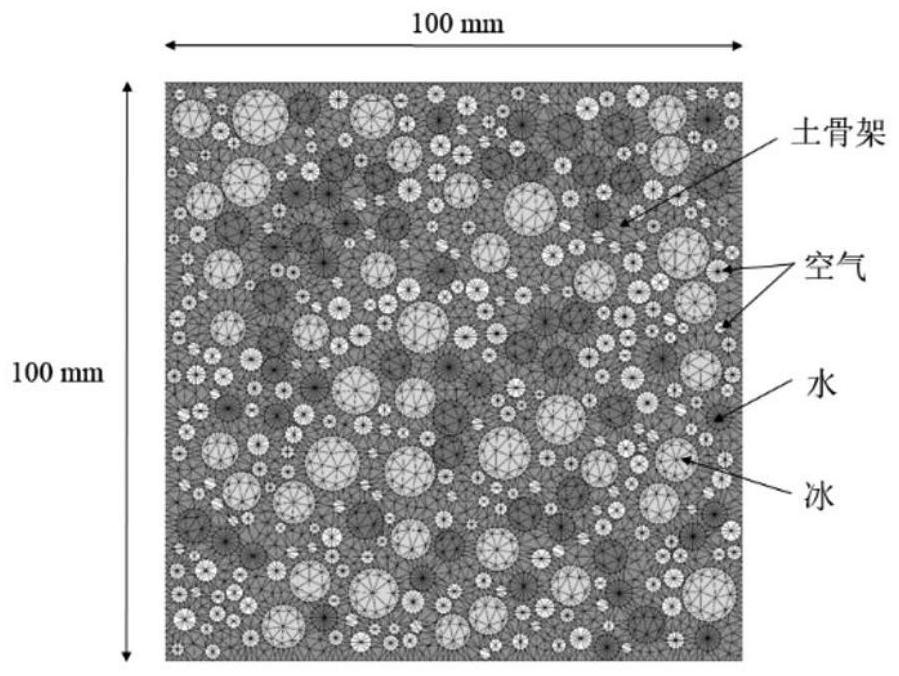Mesoscale numerical research method of equivalent thermal conductivity of rock and soil
A technology of equivalent thermal conductivity and thermal conductivity, which is applied in the field of research on the characteristics of multiphase composite materials, can solve the problems that the influence of equivalent thermal conductivity cannot be independently explored, the thermal conductivity of multiphase composite materials is complex, and the impact
- Summary
- Abstract
- Description
- Claims
- Application Information
AI Technical Summary
Problems solved by technology
Method used
Image
Examples
Embodiment 1
[0070] In this example, according to the mesoscale numerical research method of the equivalent thermal conductivity of rock and soil based on the finite element method proposed by the present invention, the influence of the spatial arrangement of dispersed phases on the thermal conductivity of rock and soil is explored. Specific steps are as follows:
[0071] (1) Determine the attributes of the research object.
[0072] ① Determine the input parameters (porosity and saturation)
[0073] The soil in the natural state is simulated, and the research shows that the moisture content of the soil in the natural state is 13%-105%, and the average value is 29%. Select typical values: porosity (n) is 50%, saturation (Sr) is 78.3%. The volume fraction of each phase is determined according to the porosity (n) and saturation (Sr). The percentage of the dispersed phase in the total volume is 50% of the porosity, and the saturation represents the percentage of the pore volume occupied by t...
Embodiment 2
[0100] In this example, according to the mesoscale numerical research method based on the finite element method proposed by the present invention for the equivalent thermal conductivity of rock and soil, the effect of soil type on the thermal conductivity of rock and soil is explored. Specific steps are as follows:
[0101] (1) Determine the attributes of the research object.
[0102] ① Determine the input parameters (porosity and saturation)
[0103] This example mainly studies the effect of soil type on the equivalent thermal conductivity, so there are no specific restrictions on porosity and saturation. The volume fraction of each phase is determined according to the porosity (n) and saturation (Sr), where the porosity is the percentage of the dispersed phase in the total volume, the saturation represents the percentage of the pore volume occupied by the water phase, and other phases can be determined according to the above two Parameter conversion results in: the soil sk...
Embodiment 3
[0130] This example explores the influence of porosity and saturation on the thermal conductivity of rock and soil based on the mesoscale numerical research method based on the finite element method proposed by the present invention for the equivalent thermal conductivity of rock and soil. Specific steps are as follows:
[0131] (1) Determine the attributes of the research object.
[0132] ① Determine the input parameters (porosity and saturation)
[0133] This example mainly studies the influence of porosity and saturation on the equivalent thermal conductivity. The porosity is not specifically restricted in the simulation, and a multiphase soil structure with a certain porosity is randomly generated. Saturation is set to 0%, 20%, 40%, 60%, 80%, and 100%, respectively. The volume fraction of each phase is determined according to the porosity (n) and saturation (Sr), where the porosity is the percentage of the dispersed phase in the total volume, the saturation represents th...
PUM
 Login to View More
Login to View More Abstract
Description
Claims
Application Information
 Login to View More
Login to View More - R&D
- Intellectual Property
- Life Sciences
- Materials
- Tech Scout
- Unparalleled Data Quality
- Higher Quality Content
- 60% Fewer Hallucinations
Browse by: Latest US Patents, China's latest patents, Technical Efficacy Thesaurus, Application Domain, Technology Topic, Popular Technical Reports.
© 2025 PatSnap. All rights reserved.Legal|Privacy policy|Modern Slavery Act Transparency Statement|Sitemap|About US| Contact US: help@patsnap.com



